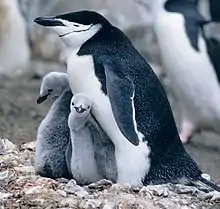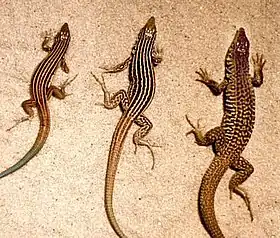有同性戀行為跡象的動物列表
在本列表中记载的有同性恋行为迹象的动物,都有文字记载的证据,这些证据包括一种或多种以下类型的同性恋行为:性行为,求偶,恋爱,配对,或育儿。这些行为都曾被研究者提及,比如布鲁斯·巴格纳尔(Bruce Bagemihl)在1999年出版的《生物的丰富性:动物同性恋与自然多样性》就曾提到这些行为。


巴格纳尔写道,直到20世纪90年代,由于社会态度对LGBT人群造成的观察者偏见,同性恋主题成为禁忌,动物同性恋性行为的存在并没有被“正式地”观察到。[2][3]巴格纳尔的书分为三章:近两百年来同性恋野生动物的历史;解释动物同性恋的产生的原因;同性恋行为不止是为了育种。他指出,“目前对生物学的无知正是在其为同性恋,变性者和非生殖和替代的异性恋寻找单一的生殖(或其他类似的)解释”。[4] 展览《违背自然?》的学术顾问佩特·贝克曼(Petter Bøckman)指出:“学多研究人员都将同性恋描述为与性行为完全不同的东西,他们必须认识到,动物可以在他们想要的时间,与他们想要的动物发生性关系,而不需要考虑研究者的伦理原则。在社会性的鸟类和哺乳动物中存在着许多同性性行为,特别是海洋哺乳动物和灵长类动物。[3]
动物性行为有许多不同的形式,即使在同一物种内,其行为的动机和影响尚未得到充分的了解。 巴格纳尔的研究表明,截止至1999年,从灵长类动物到肠道蠕虫,有记载的的存在同性恋行为的物种大约有500种,但这些行为不一定都是性行为。[2][5] 对社会保守主义者而言,动物中的同性恋行为被认为是有争议的。一方面,人们认为这表明了人类同性恋的自然性,而另一方面,有些人则认为研究动物的同性恋行为没有意义,而且将自然动物行为等同于人类的道德是荒谬的。[6][7] 动物偏好和动机总是能从其行为中推断出来。因此,多年来,同性恋行为已经被赋予了许多术语。对术语“同性恋”的正确用法是,存在同性恋行为的动物。然而,本文为了符合现代研究的方法[8][9][10][11] ,将“同性恋”应用于动物之间的所有同性性行为(交配,生殖器刺激,交配游戏和性显示行为)。
哺乳动物
- 主条目中列出的一些动物:
鸟
- 主条目中列出的一些动物:
鱼

爬行动物

The all-female Whiptail lizard species Cnemidophorus neomexicanus (center), which reproduces via parthenogenesis, is shown flanked by two sexual species having males, C. inornatus (left) and C. tigris (right). Research has shown that simulated mating behavior increases fertility for Cnemidophorus neomexicanus. One female lies on top of another, playing the role of the male, the lizard that was on bottom has larger eggs. The lizards switch off this role each mating season.[53]
- 蜥蜴[54]
- 东部鬃狮蜥[55]
- 藍尾日守宮 (Phelsuma cepediana)[56]
- 宽头石龙子[49]
- 格仔鞭尾蜥蜴[55]
- 雌吉娃娃斑點鞭尾蜥[55]
- 阿美蜥[55]
- 袜带蛇[49]
- 古巴绿蜥蜴[54]
- 沙漠绿洲鞭尾蜥蜴[55]
- 阿氏沙龟[57]
- 刺蜥[55]
- Five-lined skink[49]
- Gold dust day gecko (Phelsuma laticauda)[56]
- Gopher (pine) snake[48]
- Green anole[54]
- Inagua curlytail lizard[55]
- Jamaican giant anole[54]
- Laredo striped whiptail lizard[55]
- Largehead anole[54]
- Mourning gecko[58]
- Plateau striped whiptail lizard[55]
- Red diamond rattlesnake[49]
- Red-tailed skink[49]
- Side-blotched lizard[55]
- Speckled rattlesnake[49]
- Water moccasin[49]
- Western rattlesnake (Crotalus viridis)[49]
- Western banded gecko[58]
- Whiptail lizard spp.[55]
- Wood turtle[54]
两栖动物
昆虫

Male homosexuality has been inferred in several species of dragonflies. A survey of damsel and dragonflies reveals characteristic cloacal pincher mating damage in 20–80 percent of the males, indicating a fairly high occurrence of sexual coupling between males.[61][62]

- Alfalfa weevil[64]
- Australian parasitic wasp sp.[64]
- Bean weevil sp.[64]
- Bedbug and other bug spp.[65][66]
- Blister beetle spp.[67]
- Blowfly[67]
- Broadwinged damselfly sp.[68]
- Cabbage (small) white (butterfly)[69]
- Checkerspot butterfly[69]
- Club-tailed dragonfly spp.[70]
- Cockroach spp.[71]
- Common skimmer dragonfly spp.[70]
- Creeping water bug sp.[72]
- Cutworm[73]
- Digger bee[74]
- Dragonfly spp.[70]
- Eastern giant ichneumon wasp[64]
- Eucalyptus longhorned borer[72]
- Field cricket sp.[75]
- Flour beetle[63]
- Fruit fly spp.[76]
- Glasswing butterfly[69]
- Hypoponera opacior ant[77]
- Grape berry moth[78]
- Grape borer[72]
- Green lacewing[79]
- Hen flea[79]
- House fly[80]
- Ichneumon wasp sp.[64]
- Japanese scarab beetle[81]
- Larch bud moth[78]
- Large milkweed bug[66]
- Large white[66]
- Long-legged fly spp.[82]
- Mazarine blue[66]
- Mexican white (butterfly)[66]
- Midge sp.[82]
- Migratory locust[83]
- Monarch butterfly[69]
- Narrow-winged damselfly spp.[68]
- Parsnip leaf miner[82]
- Pomace fly[82]
- Queen butterfly[69]
- Red ant sp.[82]
- Red flour beetle[66]
- Reindeer warble fly (Hypoderma tarandi)[82]
- Rose chafer(Macrodactylus subspinosus)[82]
- Rove beetle spp.[66]
- Scarab beetle (melolonthine)[84]
- Screwworm fly[82]
- Silkworm moth[78]
- Southeastern blueberry bee[74]
- Southern green stink bug[66]
- Southern masked chafer[82]
- Southern one-year canegrub[82]
- Spreadwinged damselfly spp.[68]
- Spruce budworm moth[78]
- Stable fly sp.[82]
- Stag beetle spp.[66]
- Tsetse fly[82]
- Water boatman bug[66]
- Water strider spp.[66]
其他无脊椎动物
- Blood-fluke[85]
- Box crab[86]
- Harvest spider sp.[87]
- Hawaiian orb-weaver (spider)[87]
- Incirrate octopus spp.[86]
- Jumping spiders[87]
- Mite sp.[82]
- Spiny-headed worm[88]
Template:List of Gay and Transgender Animals footers
参考文献
- Smith (February 7, 2004)
- Bagemihl (1999)
- News-medical.net (2006)
- Bagemihl (1999) page 213
- Harrold (1999)
- Solimeo (2004)
- Solimeo (2004b)
- Bagemihl (1999) pages 122-166
- Roughgarden (2004) pp.13-183
- Vasey (1995) pages 173-204
- Sommer & Vasey (2006)
- Bagemihl (1999) page 405
- Bagemihl (1999) page 441
- Bagemihl (1999) page 469
- Bagemihl (1999) pages 388,389
- Bagemihl (1999) pages 81, 88
- Bagemihl (1999) pages 81, 82, 89
- de Waal (2001)
- Liggett (1997–2006)
- Imaginova (2007j)
- Bagemihl (1999) pages 276–279
- Bagemihl (1999) page 339
- Bagemihl (1999) page 334
- Bagemihl (1999) pages 310, 314
- Bagemihl (1999) page 427
- Bagemihl (1999) page 427
- Bagemihl (1999) pages 218, 231, 317
- Bagemihl (1999) page 391
- Imaginova (2007d)
- Bagemihl (1999) pages 81, 165, 205, 226, 231
- Bagemihl (1999) page 432
- Sell RL, Wells JA, Wypij D. . Archives of Sexual Behavior. June 1995, 24 (3): 235–48. PMID 7611844. doi:10.1007/BF01541598.
- Wellings, K., Field, J., Johnson, A., & Wadsworth, J. (1994). Sexual behavior in Britain: The national survey of sexual attitudes and lifestyles. London, UK: Penguin Books.
- Bagemihl (1999) page 455-457
- Bagemihl (1999) page 448
- Bagemihl (1999) pages 632-5
- Bagemihl (1999) pages 83
- Bagemihl (1999) pages 544-8
- Bagemihl (1999) page 621-6
- Bagemihl (1999) pages 602-5
- 365 Gay.com (2005)
- Bagemihl (1999) pages 491-5
- Bagemihl (1999) pages 606-10
- Bagemihl (1999) page 639
- Mating Call (1979)
- Bagemihl (1999), page 665
- Bagemihl (1999), page 37
- Bagemihl (1999), pages 658, 664
- Bagemihl (1999), page 658
- Bagemihl (1999), page 664
- Bagemihl (1999), pages 658, 665
- Bagemihl (1999), pages 232, 233, 244
- LeVay, (19 September 2007)
- Bagemihl (1999), page 657
- Bagemihl (1999), page 657, 658
- Budzinski, R.-M. (1997) Homosexuelles Verhalten bei Geckos der Gattung Phelsuma. Sauria 19 (3): 33-34
- Bagemihl (1999), pages 232, 664
- Bagemihl (1999), pages 663–664
- Bagemihl (1999), pages 657, 658
- Bagemihl (1999), pages 243, 664
- Dunkle (1991)
- Utzeri (1990)
- Out magazine, By The Numbers sourced to the Journal of Evolutionary Biology; February 2009. Accessed 2009-01-17.
- Bagemihl (1999), page 666
- Tatarnic1 et al., 22 March 2006
- Bagemihl (1999) page 660
- Bagemihl (1999) page 667
- Bagemihl (1999) pages 704, 713
- Bagemihl (1999) pages 150, 232, 236, 246
- Bagemihl (1999) pages 33–34, 196, 217, 219, 232
- Bagemihl (1999) page 668
- Bagemihl (1999) page 666
- Bagemihl (1999) page 595
- Bagemihl (1999) pages 9, 649, 665
- Bagemihl (1999) page 658
- Bagemihl (1999) page 3
- Kureck, I. M., Neumann, A., & Foitzik, S. . Animal Behaviour. 2011, 82 (2): 339–346. doi:10.1016/j.anbehav.2011.05.008.
- Bagemihl (1999) page 232
- Bagemihl (1999) pages 666, 660
- Bagemihl (1999) pages 661–2
- Bagemihl (1999) page 661
- Bagemihl (1999), pages 661–2
- Bagemihl (1999), page 659
- Bagemihl (1999), page 661
- Zimmer (2000)
- Bagemihl (1999) page 657
- Bagemihl (1999) pages 236, 704, 713
- Bagemihl (1999), pages 668, 667